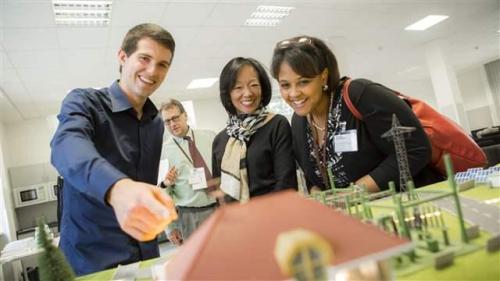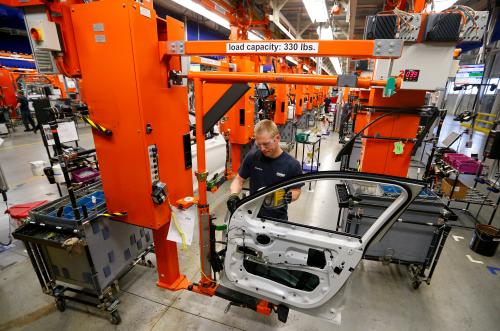U.S. cities and regions face a paradox today. Youth unemployment remains unacceptably high, yet companies say they cannot find the talent they need. As a result, many of these places are considering how they can better link the worlds of education and work for young people.
That issue was the focus of the second day of the Global Cities Initiative’s study tour last week in Germany. In Nuremberg, the state of Bavaria’s second-largest city, the U.S. delegation visited a Siemens factory and learned about the company’s approach—and that of German employers in general—to work-based education and training.
Siemens executive Jürgen Siebel began by explaining why the company believes so strongly in its apprenticeship program. For starters, youth unemployment rates are still sky-high in most of the world—14 percent in the United States and well above 25 percent in parts of Southern Europe—a threat to both economic competitiveness and societal stability. He argued that a skilled and flexible labor market is fundamental to efforts to sustain a full and lasting recovery and preserve a strong industrial base.
Achieving these outcomes requires a focus on what Siebel called a young person’s employability, the set of technical competencies and workplace norms required for success in any career. Evidence suggests that work-based education models such as the German dual system, which blends in-the-classroom theory and on-the-job training, better prepare youth to transition to the world of work. The result: Youth unemployment in Germany is much lower, at 8 percent.
The U.S. delegation heard firsthand from more than a dozen Siemens apprentices in the Nuremberg training facility, a few among Siemens’ 2,000 apprentices nationwide. Here, young people from the ages of 16 to 21 learn everything from basic production (e.g. milling, drilling, filling, etc.) to more advanced skills such as mechatronics and electrical engineering. They are pursuing a range of educational credentials alongside work, from the dual system apprenticeship, to community college and university degrees. Siemens hires the vast majority of its apprentices into full-time employment after they complete their apprenticeship. American participants remarked that beyond the first-class technical skills apprentices displayed, the apprentices’ soft skills—their ability to work in teams, their confident presentation, and their full command of English—were perhaps even more impressive.
That Siemens placed young production apprentices in front of 60 high-level foreign leaders speaks volumes about their confidence in them. In an evening reception, Louisville Mayor Greg Fischer noted that Siemens exemplified the German attitude that blue collar and white collar work are equally valued. Siemens Corporate Vice President Pedro Miranda remarked that the future of the company’s business—responding to the economic and technological disruptions from electrification, automation, and digitization—requires Siemens to develop and integrate incredibly complex technologies and systems. In turn, Miranda said, Siemens needs not only to “buy,” but also to “make,” the next generation of its workforce though vocational education, from the design lab to the factory floor.
The visit to Nuremberg reinforced that in a global economy firms have choices and will look to places that can offer them the talent they need. U.S. regions seeking new investment and job growth, especially opportunities for young people, would do well to learn from the experience of Siemens and other German firms that are actively building their future workforce.
Siemens AG provides financial support for Brookings.










Commentary
Training a Next-Generation Workforce in Nuremberg
November 24, 2014